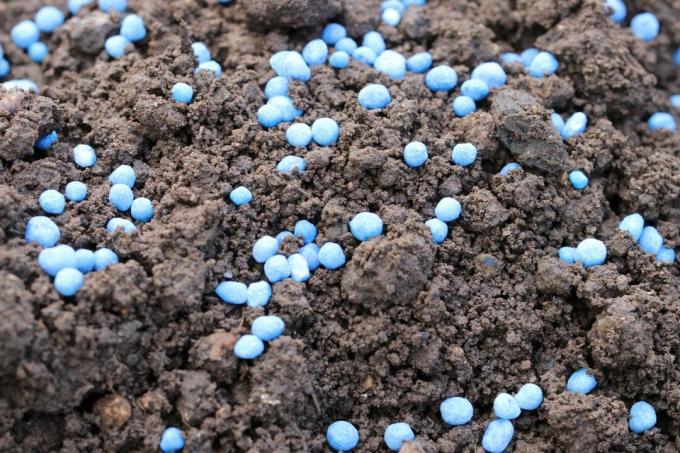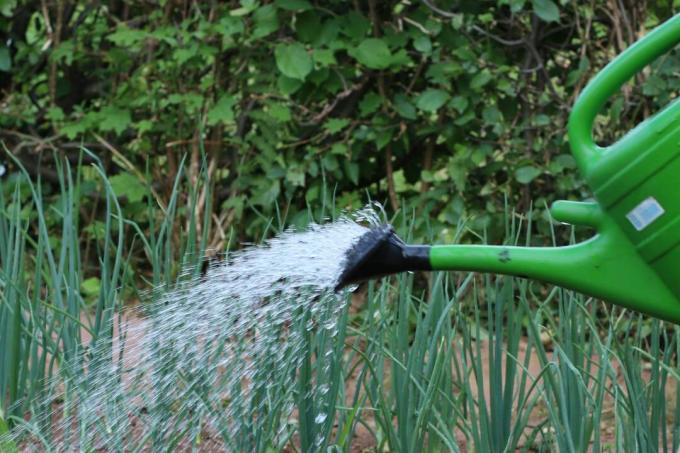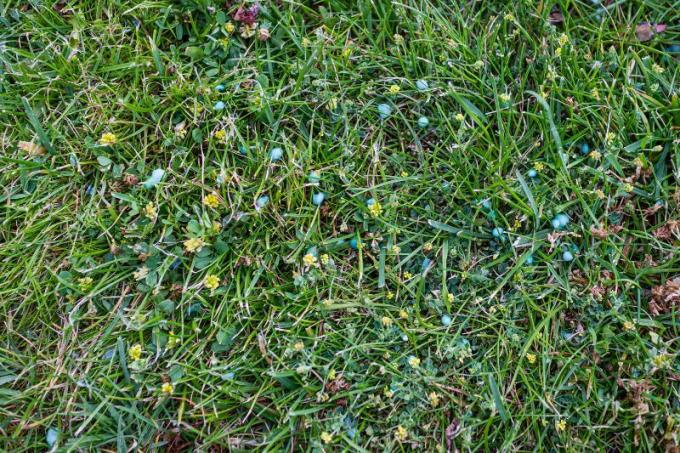
Plants need oxygen, water and nutrients to grow. Blaukorn offers all sorts of the latter. That is why many hobby gardeners swear by the fertilizer. You can sprinkle blue grain or dissolve it in water. However, there are a few things to consider.
In a nutshell
- Blue grain chemically produced fertilizer
- contains nitrogen, potassium, phosphorus
- Administration in granular form
- also dissolving in water possible
- plus 5 to 6 g per 10 liters of water
Table of Contents
- Blue Grain as Fertilizer
- application and dosage
- In granular form
- Dissolved in water
- Plants that like blue grain
- frequently asked Questions
Blue Grain as Fertilizer
Blaukorn is an artificial fertilizer made from inorganic salts in the shape of a blue ball. It provides the plants with all the nutrients they need for growth
- nitrogen
- potassium
- phosphorus and
- Additives such as magnesium, sulfur
It is therefore also used as a complete fertilizer or NPK fertilizer designated. Many hobby gardeners rely on the use of blue grain when fertilizing
- nutrients are readily available
- rapid reaction to nutrient deficiency is possible
- Deployment and distribution is easy

A notice: Blue grain (left) can quickly with the similar looking slug pellets (right), which has a different effect.
application and dosage
The application of blue grain is relatively simple. When using it, however, be sure to follow the manufacturer's instructions on the packaging. This complete fertilizer should be used between March and September. It is beneficial to treat the bed area a week before sowing or planting out. This gives the fertilizer enough time to develop its full effect. If required. can also be fertilized in small doses with blue grain after three to four weeks during the growth phase. There are two ways to apply fertilizer:
In granular form

- choose a cloudy, rainy day
- otherwise occurrence of burns
- do not sprinkle directly on plants or leaves
- Soil should be slightly moist
- Distribute blueseed evenly around plants
- easily incorporated into the soil
- then water well
A notice: The artificial fertilizer needs moisture to dissolve so that the nutrients can then be given to the plants in good doses.
Dissolved in water
In addition to fertilizer in granular form, you can also dissolve blue grain in water and administer it in liquid form. Then add five to six grams of blue grain to 10 liters of water. For a smaller pitcher, scale down the amount of blue grain accordingly. When dissolving the complete fertiliser, be careful and prudent:
- Blue grain is difficult to dissolve
- Leave mixture overnight
- stir well before use
- Thoroughly clean the watering can afterwards
- remove all remains from the bottom of the jug
- otherwise the fertilizer concentration will increase unintentionally at the next fertilization
- Application within the growing season
- once a month

A notice: Before using blue grain, a soil analysis should be carried out to determine the nutrients present. Otherwise, the soil can quickly become over-fertilized.
Plants that like blue grain
Not all plants tolerate blueseed equally well. For some plants, growth and flowering get a big boost. The result is a bountiful harvest. Below is a selection of plants:
vegetable plants
- Cauliflower (Brassica olreacea var. botrytis L.)
- Peas (Pisum sativum)
- Cucumbers (Cucumis sativus)
- Potatoes (Solanum tuberosum)
- Lettuce (Lactuca sativa var. capitata L.)
- Carrots (Daucus carota)
- Parsely (Petroselinum crispum)
- Tomatoes (Solanum lycopersicum)
- onions (Allium cepa)
fruit trees and shrubs
- Blackberries (Rubus sectio Rubus)
- Strawberries (Fragaria)
- raspberries (Rubus idaeus)
- Currants (Ribes)
- Gooseberries (Ribes uva-crispa)

ornamental plants and shrubs
- Fine Beam Aster (Erigeron)
- lady's mantle (Alchemilla)
- Cherry laurel (Prunus laurocerasus)
- oleander (Nerium oleander)
- rhododendron (rhododendron)
- Larkspur (Delphinium)
- Tulips (Tulipa)
frequently asked Questions
For plants that are on nutrient-poor soil, you should refrain from using blue grain. You can recognize such soils from indicator plants such as trefoil (Lotus corniculatus) or cranberries (Vaccinium vitis-idaea). Nasturtiums (Tropaeolum), poppies (Papaver) and ericaceous plants also do not tolerate the fertilizer. In general, young plants should not be fertilized with blue grain, as the roots are very sensitive to it.
Yes, the fertilizer is toxic to humans, domestic and wild animals. Direct skin and eye contact can cause severe irritation. If the blue grains are swallowed, acute symptoms of poisoning such as vomiting, bloody diarrhea, stomach cramps, collapse, respiratory and circulatory problems and even coma occur. Particular caution is required when spreading if small children and pets can come into contact with it.
In the event of skin contact, the affected areas must be rinsed thoroughly with water. If swallowing is suspected, no unauthorized measures should be taken. Activated charcoal should only be used for vomiting in consultation with a doctor or veterinarian.
As already mentioned, blue grain is produced purely chemically. There are no organic substances contained here. However, these are important for the nutrition of the microorganisms in the soil. The organisms, in turn, are necessary for the fertility of the soil. They are responsible for the formation of humus and bring the soil structure into balance. Blue grain pollutes the soil as well as the entire environment in the long term, for example components get into the groundwater.
Various organic natural fertilizers can be used here. These supply the plants with the necessary nutrients and are harmless to humans and animals. Use can be found here: compost, horn shavings, nettle manure, green manure, liquid manure, sugar beet molasses, straw. There are also various organic fertilizers on the market.
